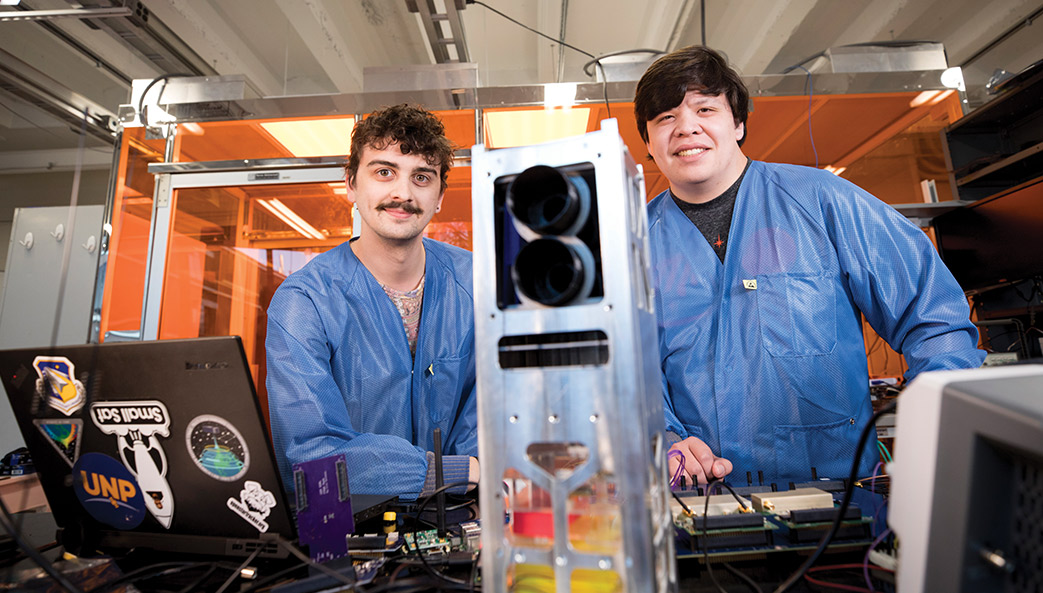Space Dawgs

Caleb Adams (left) and Graham Grable are part of the team that helped build this CubeSat and launch UGA’s Small Satellite Research Laboratory. (Photo by Dorothy Kozlowski)
By Aaron Hale
Caleb Adams (BS ’18) was looking for the next challenge. He and a group of friends—self-described geeks—had just created a smartphone-controlled telescope and launched a company to sell it.
He landed on cube satellites, or CubeSats, a class of miniature spacecraft shaping the next stage of space technology. CubeSats are compact and fairly inexpensive, at least compared to large communications and research satellites. Because they’re small and cheap, and because there have been huge strides in fitting high-powered computers into tiny devices, CubeSats are tissue box-sized vessels for innovation. Adams remembers thinking, “How hard can it be?”
Perhaps it’s fortunate he didn’t realize that competition for CubeSats is fierce, with universities vying for the limited approval and academic funding available to send a small satellite into space. But Adams and his friends aren’t easily daunted.
“I was looking for the most difficult thing I could find and throwing myself at it,” says Hollis Neel (BS ’17). “That’s a theme you’ll find with a lot of us: We really enjoy a challenge.”

As it turned out, faculty in the Franklin College of Arts and Sciences geography department had already been exploring CubeSats. Associate professor Deepak Mishra and research scientist David Cotten are monitoring the coastal water quality and wetland health around Georgia’s Sapelo Island. They are tracking algae blooms, sediment and organic matter in the water—all vital indicators of coastal and wetland health.
In addition to gathering data on the ground, the researchers verify their findings with visual information gleaned from large research satellites operated by NASA and the European Space Agency. But the satellites have set overpass times, usually going over Sapelo Island just a few times a month—a big data gap. Mishra hoped a new satellite could give them a clearer picture of coastal health.
They joined forces to create UGA’s Small Satellite Research Laboratory, staffed by about 50 students—ranging from STEM majors to those in business and the arts—and guided by faculty in geography, engineering, math, physics, chemistry and oceanography.
The students first secured NASA funding for a SPOC (SPectral Ocean Color) Satellite. The payload would have optics capable of zooming in on coastal areas and then splitting the light on the water or wetland surface to determine dominant colors. Those colors reveal the chemical and molecular makeup of the ocean and wetland surface and signs of coastal health.
Then they secured funding from the Air Force Research Laboratory’s University Nanosatellite Program, successfully competing against some of the nation’s top established aerospace programs to secure one of two winning spots.
Their second satellite design, MOCI (pronounced mo-chee), or Multi-view Onboard Computational Imager, is designed to take images from low orbit and then compute data before sending it back to ground control. It’s an innovative approach; typically, NASA missions send raw data back to Earth to be processed.
SPOC and MOCI are slated for launch in late 2019 and 2020, respectively. In just three years, UGA’s involvement with space-systems development has transformed from big idea into reality. Even the experts are impressed.
“I’m astonished by how far and how fast they’ve come in a short amount of time,” says Roger Hunter (BS ’78), program manager for NASA’s Kepler Mission, who now manages the Small Spacecraft Technology Program at the Ames Research Center in Silicon Valley.
Adams says the students are inspired by the possibilities this work can support.
“At the end of the day,” he says, “our goal is to support our faculty and create tools that help them do science.”
This story was published originally in the December 2018 issue of Georgia Magazine. The original story is available at https://news.uga.edu/space-dawgs/.
